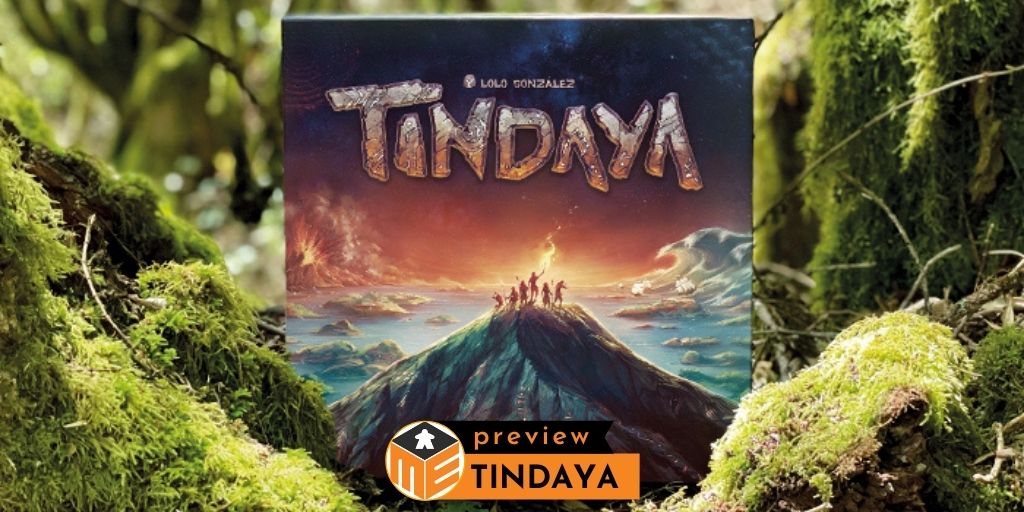SPIEL Messe 2021 was over, but we still have some games to talk about from the event. This time, we’d like to talk about a new title from Red Mojo. Under the flag of this Spanish publisher, Lolo González brings up his latest creation, Tindaya. According to their information, it will seek for funding through Gamefound in 2022. They already open the page for subscriptions, and you can follow their project.
Disclaimer: We had the preview copy for this review, and it was not the final version. There might be possible changes and alteration from the publisher regarding the components, printing and build quality, rules and concepts in the official released product.
A short disclaimer before you read my board game analysis
As an avid euro gamer and hardcore Legend of the Five Rings (L5R) LCG player, my reviews may reflect a preference for these styles, and I may not cover solo games/variants extensively. Please note that my personal remarks are based on my gaming experiences, and I aim to provide honest insights within the scope of my preferences.
There are already some videos on YouTube that explain the rule and show how to play Tindaya. I suggest that you watch them first before reading even further.
TINDAYA’S BACKGROUND STORY
Tindaya Mountain has been deemed as a sacred site ever since the pre-colonial era by the aboriginal population. As Lolo comes from the Canary Islands, a Spanish archipelago off the coast of Africa where this mountain is located, he wants to introduce the story of his birthplace. Nothing beats board games as the media to spread such tale.
As one of the aboriginal tribes, players try to survive by fighting both colonial armies and appeasing the Gods and Goddesses. Yes, you read it right, we are going to play against the supernatural power besides waging war against the conquerors. At first, I thought the anti-colonial theme would have been like Spirit Island, where both the ‘locals’ and the divine deities work together to repel them. This is not what’s happening in Tindaya, guys. From this moment, we can expect something fresh from Lolo’s latest piece.
SOME MEMORABLE THINGS FROM TINDAYA
Life is quite hard in Tindaya, I tell you, and we would have many things happening on the board. Anyway, the game comes with both competitive and cooperative modes.
Even the competitive one needs all players to be a bit cooperative, especially with the appeasing the Gods and Goddesses part. Nevertheless, in my opinion, Tindaya is not a semi-coop game. It is more a semi-competitive game (I will explain it later below). We didn’t have the time to try the cooperative one, and this preview was based on the competitive mode.
At the beginning of the game, all players choose secretly a Secret objective, and give their objectives a positive or negative point.
These objectives can reward or penalize points when fulfilled by any player. This is an interesting mechanic that I have never found in other games.
THE GODS’ AND GODDESSES’ WRATH IS ABSOLUTE
Not only we need to ward off the conquerors, appeasing the ancient beings was not a piece of cake either. The latter one was something I found interesting. If we didn’t offer things for them, they would get mad, and disasters happened. When we extracted too many resources, they also got unhappy. Pleasing them didn’t mean that their wrath wouldn’t take place, though!
The disaster still happened, and the difference was in how devastating it could be. If their demand was fulfilled, their wrath wasn’t that bad. It could still destroy what you have built, but at least you didn’t lose everything. However, when they were enraged, well, they could even take out the whole archipelago.
Now, appeasing the god is important to keep what you have on the board intact. We are trying not to make the wrath as mild as possible, but our goal is to make the wrath not to touch our settlements. This is why the game becomes semi-competitive.
MODULAR MAIN BOARD & BUSY PLAYER BOARDS
Tindaya’s main map utilizes a modular, hexagonal tiles. It depicts the Canary Islands, which landscape could change due to the disaster coming from the deities. This modular map is coupled with both the mechanics in this game, area majority and grid movement.
The player boards look busier than the main board, and most of them are there to do the production actions. It feels like the console to build the civilization. Some parts are locked, and it needs to get upgraded to survive with our tribes. Here, we could see the worker placement. We place cubes or cylinders to activate the actions. Anyway, unlocking the parts gave us accesses to other resources we can produce.
MORE INTERESTING THINGS IN THE GAMEPLAY
To move around the islands, the tribe must build a canoe. Moving is important to reach a new space for settlements and resources. It is helpful to flee from the disaster before it happens. This canoe is not privately owned by the tribe who built it in the first place. I like the idea of this aspect, mostly because I can spare my resource to build one if I can find a free canoe lying around my territory.
Why is sparing resources important? Tindaya is a game with just-about-right morale. Too many resources, and all the Gods go crazy and can cost you points. Too few, however, would not help you to advance your civilization. Besides, the resources are scattered around the archipelago, and it is not a good idea to waste time and action to wander off and blindly use the resources we have.
Tindaya has a high player interaction, thanks to the semi-competitive nature. In addition, the way to unlock some locked parts on the player board. Players have to ‘teach’ each other how to produce things along the way. This is also a unique feature that goes well along the theme.
VERDICT
Tindaya is a complex game, and each game feels tight and intense. I wouldn't categorize it as a medium one. It deserves a place in the list with other heavy-hitter games.
It is a nice game to back if you are a fan of euro game. Despite being too punishing for my taste, I would say the game is memorable, not only because it takes time and will be engraved in your mind for a long time, but also due to its unique and nice gameplay.
The game revolves around ‘planning for the best, but preparing for the worst’ because of the semi-competitive among players. Nevertheless, it is a bit far-fetched to say that it doesn't have the strategy aspect at all. With that being said, it is a more tactical game rather being a strategical one. We mostly played to survive in the present.
Do you love board games as much as we do? Support us!
Thank you for reading our articles! If you enjoyed our work and want more captivating board game contents, make sure to:
👉 Follow us on our social media — you can find us on ![]()
![]()
![]() Click one of the icons to land on our social media, or find us @meepleeksyen there, it's just a click away! Stay updated with our latest board game reviews and previews by following us on those platforms 📱👍
Click one of the icons to land on our social media, or find us @meepleeksyen there, it's just a click away! Stay updated with our latest board game reviews and previews by following us on those platforms 📱👍
💬 Do you have contrasting opinions? Leave a comment — share your thoughts with us, we'd love to hear (or read) yours! Have you played this game before? Did you have something similar as well? Or perhaps, something more personal, like what are your favourite board games? Let's discuss in the comments below!
🙏 Support Us! Your generous support can help us produce even better content in the future. If you love what we do, consider making a donation to our blog. Every contribution counts and means a lot to us! You can either donate locally with Indonesian Rupiah (IDR) via Trakteer ![]() or for international readers with another currency through Buy Me a Coffee
or for international readers with another currency through Buy Me a Coffee ![]() It helps us to survive, too! 💰 Click one of the button below 👇
It helps us to survive, too! 💰 Click one of the button below 👇
All pictures in the slideshow are courtesies of Red Mojo Games.
I am a full-time food technologist during weekdays. However, when the calendar hits weekends, I transform into an avid board gamer. I am a hardcore Legend of the Five Rings (L5R) LCG player from Fantasy Flight Games (FFG). Current hobby: buying board games. My shelf of shame’s list is getting longer, thanks to you, Kickstarter.









